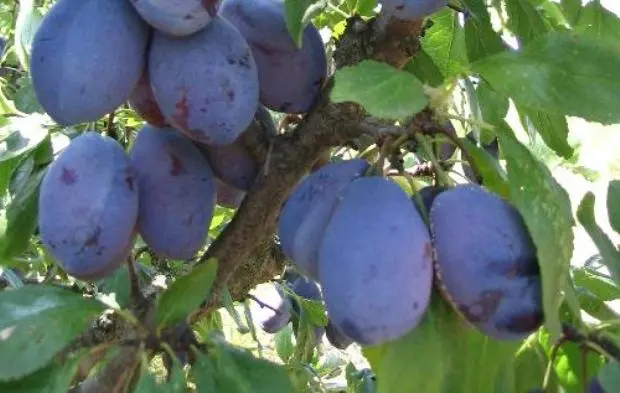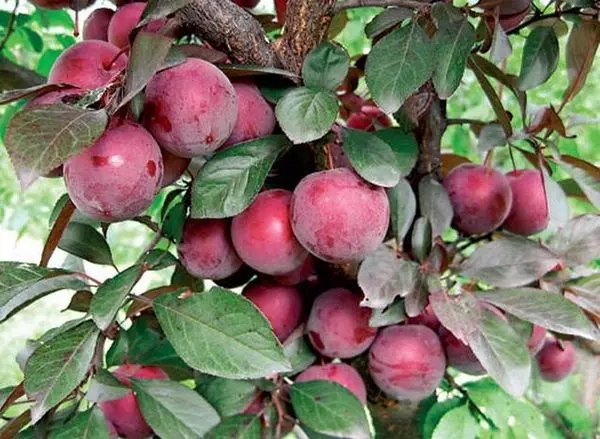Contents
There are about 30 main varieties of plums on earth. At the same time, many varieties have divisions into narrower subspecies that were bred by breeders. Today we will talk about plum Hungarian. The variety of its species is really surprising – Moscow, Korneevskaya, Belarusian, Italian, domestic, Donetsk and others. Below we will present a detailed description and the main advantages of each Hungarian variety.
Variety description
Hungarian has always collected only good reviews from gardeners. This variety combines plums with dark purple skin, smoky bloom and egg-shaped fruits. The pulp is juicy and soft. The fruit is easily divided into halves.

It is worth noting that prunes are prepared only from this variety, since it contains the optimal amount of sugar and pectin, which allows such processing.
The name of the variety comes from the historical localization of the tree. The first Hungarians were discovered in the XNUMXth century on the territory of Hungary. At that time, local residents already knew about the features of these plums and did not pick them from the tree, but waited until they overripe and fell to the ground already a little dried up.
Although the subspecies of the presented variety have a number of unifying characteristics. They also have significant differences. For example, Belarusian Hungarian is a mid-season variety with large fruits up to 40 grams. The flesh is colored orange. Donetsk Hungarian is characterized by early maturation of plums. Fruits are gaining the desired shape and structure by the 2nd decade of August.
The pulp of the Donetsk plum is olive-green, slightly sour. According to reviews, it is considered the most suitable for drying and canning as a compote. The Donetsk variety tolerates frosty winters well and begins to bear fruit for 4-5 years. We will analyze the description of the remaining subspecies in more detail.
Italian
This variety comes from sunny Italy, so the frost resistance of the trees is poor. The variety is intended for cultivation in the southern regions with a mild climate. The crown has a rounded shape. Plums ripen rather late. The fruits are large, fleshy, distinct egg-shaped. Italian Hungarian has subcutaneous spots and a small white coating on a dark blue skin. The pulp is painted in a light green color. Near the bone, it is denser with red streaks. The aroma is moderate.

The yield of the variety is excellent. Young trees 5-6 years old, under proper conditions, give about 50 kilograms of fruit. In the warm Black Sea zones, cases were recorded when 10-year-old trees produced from 100 to 200 kilograms of fruit. As for diseases and pests, the Italian Hungarian is moderately resistant to codling moth and clasterosporia.
Video “Description of Hungarian plum”
Home
This variety is distinguished by increased frost resistance and a degree of protection against diseases. The trees of the Home Hungarian grow tall with sprawling and dense pyramidal branches. Due to their excellent transportability and keeping quality, plums are suitable for cultivation for sale. Ripe fruits can be stored for about 15-25 days. You should also pay special attention to productivity. Due to the high rates of resistance to diseases and pests, adult plums produce 150-180 kilograms of fruit per tree.
But such a yield is possible only with proper care. This variety loves moist and fertile soils. In sandy and dry soil, fertility will be significantly lower. Home plum is self-fertile, although experts recommend planting Renklod Altana or Anna Shpet as neighbors. Collection of plums must be planned for the first days of September.
Moscow
This variety was specially bred for cultivation in central Our Country. Plums endure frosty winters, and if freezing occurs, the plants successfully recover from them. The fruits of the Moscow plum are average up to 30 grams with a dense peel. The surface of the fruit is covered with a blue-gray bloom. The flesh is honey colored. It is juicy and moderately sweet, although in taste it is noticeably inferior to southern varieties.

The trees of the Moscow Hungarian are of medium height – up to 3 meters. The first harvest appears quite late, at 6-8 years, while quite a lot of plums form on the tree. Every year, more and more fruits appear, subject to quality care. From 1 tree you can collect about 35-40 kilograms of fruit.
Wangenheim variety
This is the most frost-resistant variety of the above. Trees form a powerful dense crown. The fruits ripen early – by mid-August. Plum is developing rapidly and already for 6 years is capable of yielding up to 15 kilograms. An adult tree produces 50-60 kilograms of fruit per year. The fruits of Wangenheim are average about 30 grams each.
Plums are amber on the inside and dark blue on the outside. On the skin there is a characteristic bluish coating. As for the taste characteristics, the fruits are very juicy and moderately sweet. For a quality harvest, it requires fertile soils, although it feels satisfactory in poor soils.
Video “What does a Hungarian look like”
This type of garden plum is one of the most prolific. A solid harvest can be obtained even from a small tree.










